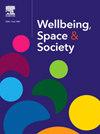Nature experiences and their potential therapeutic benefits for psychiatric assisted-living residents recovering from substance abuse
IF 2.2
Q2 GEOGRAPHY
引用次数: 0
Abstract
Background
There is a lack of research on nature in psychiatric assisted-living facilities and the mechanisms between nature experiences and mental health. The use of the therapeutic landscapes concept in this context seems promising. To address this research gap, an exploration of the natural environment of an assisted-living facility for people with chronic mental illnesses and a history of substance abuse is presented and contextualized in therapeutic landscapes.
Methods
Qualitative interviews were used to examine what kinds of nature experiences residents had in their daily lives and whether and how these experiences could potentially be therapeutic for them. The interviews were then analyzed using content analysis with a deductive-inductive content structuring approach and an analysis of overlap.
Findings
Six different kinds of nature experiences were identified. These were, to varying degrees, associated with eight different kinds of potential therapeutic benefits that support the residents’ recovery and promote their well-being. Residents’ nature experiences also showed considerable overlap with the other therapeutic landscape environments – the social, built, and symbolic environment.
Conclusion
This study is the first to demonstrate how mental health and place are intertwined for psychiatric assisted-living residents with mental illness and a history of substance abuse. The natural environment in and around these facilities and the experiences they enable can play a key role in recovery and the promotion of well-being. The diverse association between the kinds of nature experiences and their potential therapeutic benefits has implications for policy and practice.
自然体验及其对精神科辅助生活居民从药物滥用中恢复的潜在治疗益处
背景精神科生活辅助机构的自然体验以及自然体验与心理健康的关系机制研究不足。在这种情况下使用治疗景观概念似乎很有希望。为了解决这一研究缺口,对慢性精神疾病和药物滥用史患者的辅助生活设施的自然环境进行了探索,并在治疗景观中进行了背景化。方法采用定性访谈的方法来研究居民在日常生活中有什么样的自然体验,以及这些体验是否以及如何对他们有潜在的治疗作用。然后使用演绎-归纳内容结构方法和重叠分析的内容分析对访谈进行分析。研究结果确定了六种不同的自然体验。这些在不同程度上与八种不同类型的潜在治疗益处相关,这些益处支持居民的康复并促进他们的健康。居民的自然体验也与其他治疗性景观环境——社会、建筑和象征环境——有相当大的重叠。结论本研究首次展示了精神疾病和药物滥用史的精神辅助生活居民的心理健康和场所是如何交织在一起的。这些设施内部和周围的自然环境以及它们所带来的体验可以在恢复和促进福祉方面发挥关键作用。各种自然体验及其潜在治疗效益之间的不同联系对政策和实践具有重要意义。
本文章由计算机程序翻译,如有差异,请以英文原文为准。
求助全文
约1分钟内获得全文
求助全文
来源期刊

Wellbeing Space and Society
Social Sciences-Social Sciences (miscellaneous)
CiteScore
2.70
自引率
0.00%
发文量
46
审稿时长
124 days
 求助内容:
求助内容: 应助结果提醒方式:
应助结果提醒方式:


